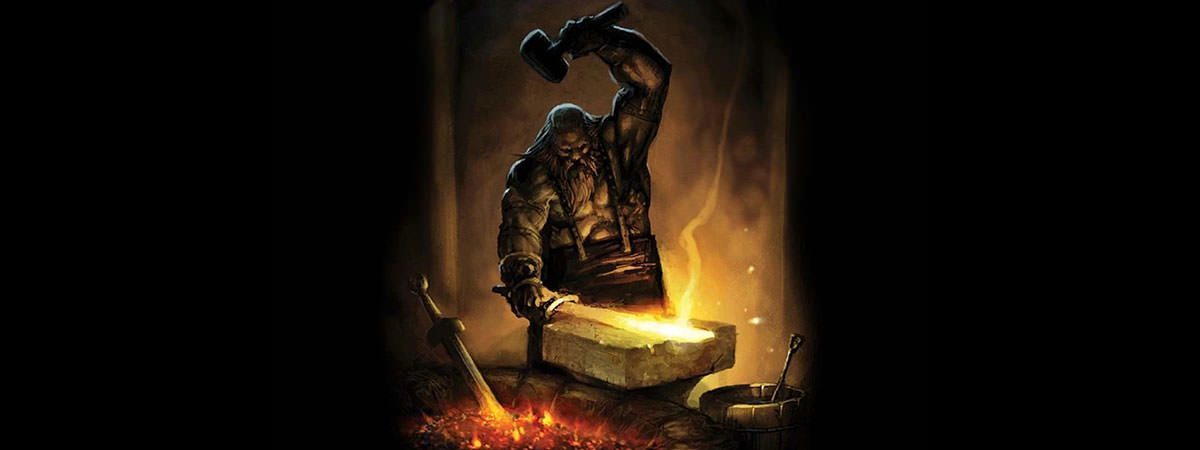In the ancient Greek religion, Hephaestus was the ‘God of fire and volcanoes’. He is referred to as the ‘celestial artificer’, credited with creating numerous exquisite weapons, tools and artifacts for the Olympian Gods and Greek Heroes. Hephaestus was thus also regarded as a smithing God and worshiped by metal workers, sculptors, masons and other such artisans. Being ugly in appearance, stocky and lame of foot, Hephaestus is unique among the other perfectly beautiful Olympian Gods. He is often depicted walking with the help of a cane and referred to by epithets like “the halting” and “the lame”. Being a smithing God, Hephaestus may also be depicted at his work bending over an anvil. The symbols associated with him were a smith’s hammer, anvil and a pair of tongs and he is known to have been worshiped in the manufacturing and industrial centers of Greece, particularly Athens.
Hephaestus is identified as the son of the supreme God Zeus and his queen Goddess Hera. The young Hephaestus grew up in the Greek island of Lemnos, where he learned his craft away from Mount Olympus. He would later return to the abode of the Gods and craft the most fabulous weapons and objects known in the Greek myths, including the palaces of all the Gods and Goddesses on Olympus. The ugly Hephaestus is interestingly married to Aphrodite, the Goddess of love and beauty. Their marriage arranged by Zeus (alternatively Hera) is however an unhappy union and the Goddess is often unfaithful to him. Along with the Goddess of wisdom Athena, Hephaestus is believed to have bestowed the arts on mankind and several Greek myths recognize him among the 12 major Olympian Gods. Here are 10 interesting facts that help us know more about the Greek God of fire and volcanoes.
#1 His worship possibly predates the Ancient Greeks
The excavations carried out in the Greek island of Crete between 1900-1970 led to the discovery of the city of Knossos, now identified as Europe’s oldest city. This city was the political center of what we call as the Minoan civilization, a Bronze Age (3300-1200 BCE approx) Aegean civilization that possibly stimulated the civilizational growth of Mycenaean Greeks. An inscription suggesting the worship of Hephaestus has been found in the excavated city of Knossos. This inscription is written in Linear B, the syllabic script used by the Mycenaean Greeks which predates the Greek alphabet by several centuries. The Greek theonym Hēphaistos may thus belong to the group of pre-Indo-European languages spoken in prehistoric Greece, pointing to the pre-Greek worship of the God.
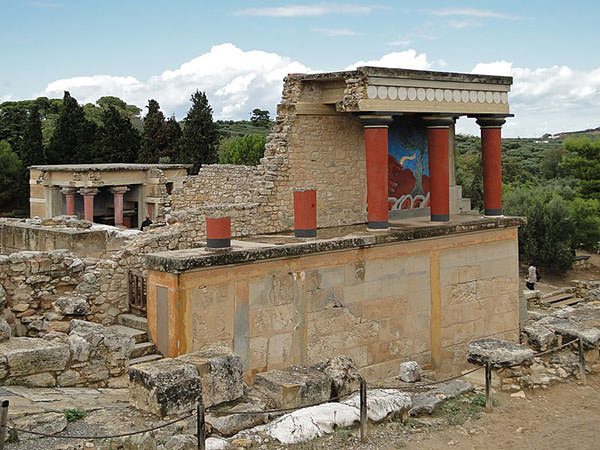
#2 The cult of Hephaestus was based in Lemnos
According to ancient Greek mythology, Lemnos was the island of Hephaestus. According to some stories (like The Iliad), Hephaestus was thrown off from heaven by Zeus when he tried to rescue his mother Hera from Zeus’s advances. The God of fire fell for a day landing on the island of Lemnos where he was welcomed and taken care of by the Sintians, the tribal natives of the island, who trained him to be a master craftsman. When he grew up, Hephaestus set up his workshop in Lemnos and became the patron God of the island.

Other branch of myths (like Apollodorus) hold Hera responsible for throwing Hephaestus from Olympus, as she was ashamed of her ugly and deformed child. In these stories Hephaestus is raised in Lemnos by sea nymphs Thetis and Eurynome. Some stories also incorporate both of the stories mentioned above. The first fall due to Zeus results in Hephaestus losing his leg while the second fall due to Hera lands him in Lemnos, where Thetis and Eurynome function as his surrogate mothers for nine years. In yet another story, Hephaestus was the child of Zeus and Hera before their marriage, born on Lemnos island. He was left here in the care of a blacksmith named Kidalionas, and Hephaestus learned the blacksmith trade from his caretaker. Besides Athens, Lemnos saw the worship of Hephaestus. The ancient capital of the island was named Hephaistia in honor of the god.
#3 He is said to have been Hera’s child through parthenogenesis
The mythology regarding Hephaestus’ birth is inconsistent but the more accepted idea is that the queen Goddess Hera created him on her own. According to the adage, Zeus before his marriage with Hera was married to a Titaness named Metis. Realizing that Metis would eventually get impregnated and bear a son who may be strong enough to overthrow him one day, Zeus became insecure and concerned. He thus turned his first wife into a fly and swallowed her without knowing that she was already carrying his first child. This later led to Zeus having severe intolerable headaches, making him desperate for relief. Finally one day he ordered his head to be split open, and from her father’s head emerged the Goddess Athena.

The birth of Athena enraged Hera, who felt betrayed as a wife and was jealous that Zeus had given birth to such a glorious child all by himself. Out of her envy, she resolved to have a child all by herself. Hephaestus was thus born from Hera’s will through parthenogenesis (reproduction without fertilization). However unlike the perfectly born Athena, Hepheastus was ugly and born with deformity. Disgusted by her son’s imperfections and her failure, Hera rejected Hephaestus at birth.
#4 He nailed Prometheus to a rock
According to Greek mythology, the forge of the god Hephaestus was located in the Mosychlos volcano, in the Lemnos Island. At the foot of this burning mountain there once existed an ancient temple dedicated to the God of Fire. It was believed that it was from this very place that Prometheus had stolen the heavenly fire from the Gods. Prometheus was later punished by the Gods and nailed alive to a rock in the Caucasus mountains by Hephaestus. His punishment would not end here and Prometheus’ liver was gnawed by an eagle sent by Zeus only to grow back afresh each day, such that he would suffer for eternity. Fortunately, after many years, the great hero, Hercules, killed the eagle, rescuing Prometheus from his torment.
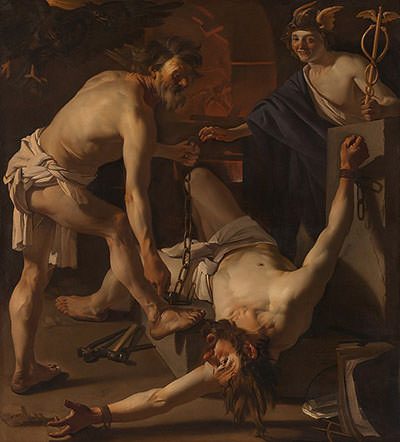
#5 The festival of Chalkeia and Apaturia in Athens honored him
Outside the island of Lemnos, the cult of Hephaestus was prevalent in Athens, where large number of people employed in metal-working, pottery and such crafts recognized him as their patron god. The festival of Chalkeia was celebrated on the last day of Pyanepsion (October or November in the Attic calendar). It was the festival of artisans and bronze workers. The festival celebrated Athena and Hephaestus, honoring both gods as patron deities of Athens and as deities of handicrafts. In the same month of Pyanepsion, the festival of Apaturia was also celebrated in Athens. In this festival young men received the initiation which they needed in order to get married, at the temples of Zeus and Athena. Hephaestus was not celebrated here as the God of fire, but as bridegroom, husband and father of a divine child. Torches were lit at his hearth, songs were sung in his praise and sacrifices were made to him.
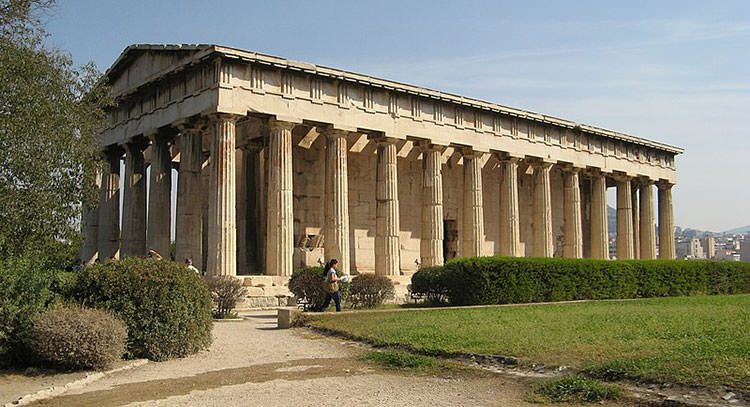
#6 Gods similar to Hephaestus are present in several ancient cultures
As the Romans took over from the Greeks, Hephaestus was adapted into the Roman God Vulcan like the other deities of the Greek pantheon; Zeus (Jupiter), Hera (Juno), Athena (Minerva), Ares (Mars), Hermes (Mercury), Aphrodite (Venus), Poseidon (Neptune), Demeter (Ceres), Artemis (Diana) and Hestia (Vesta). Gods that seem similar to Hephaestus are also observed in other ancient cultures. The Egyptian God Ptah was revered as a patron of craftsmen and architects. In Germanic/Norse mythology, Wayland the Smith is considered as a master blacksmith who used his supernatural skills to forge exquisite weapons and ornaments. In the Vedic and Dharmic traditions from India (Bharata) Gods like Tvastr, Vishwakarma and Agni are prominent examples. The White Tengri or the good gods of the Buriats, are said to have sent down to Earth the celestial smith Boshintoi and his family, who taught human beings the art of metallurgy. The Mesopotamian deity Mummu is a craftsman, considered as the personification of practical knowledge and technical skill. Also, for the Phoenicians, Chusor is a God of the armorers, blacksmiths and fishermen, credited with the invention of fishing, navigation and the forge.
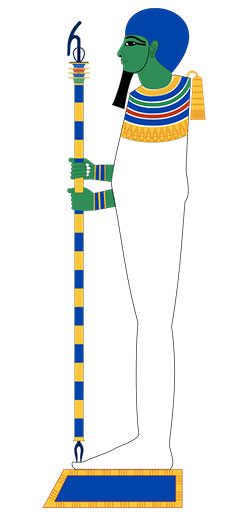
#7 He is not the only smiting God who is deformed
Though the lame and ugly Hephaestus is unique among the other perfectly beautiful Olympian Gods, he is not alone when we observe other ancient cultures. The Egyptian god Ptah for example may sometimes be seen represented as a dwarf who is naked and deformed. Another prominent example is Wayland The Smith from the early-Germanic/ Norse stories. In the poem Völundarkviða which may be found in in the 13th-century Icelandic ‘Poetic Edda’, a collection of very Old Norse poems, Wayland was once captured by an evil king of Sweden (King Nidud) who made him lame such that Wayland may not escape. Kothar-wa-Khasis is an Ugaritic (an extinct Semitic language) god whose name may be translated as “Skillful-and-Wise”. Another of his names, Hayyan hrs yd means “Deft-with-both-hands” or “of skillful hands”. Is is said that Kothar was identified from afar by his distinctive walk – possibly suggesting that he limps.

Examples such as above have led some researchers to deduce that these stories may be indicative of the real-world danger associated with Bronze Age metallurgy. Apart from the obvious hazards of the professions it has been observed that ancient metalworkers were using poisonous substances (perhaps unknowingly) like arsenic in the production of bronze. Prolonged exposure to such substances may cause disfigurements, nerve damage and several other problems in the human body.
#8 Hephaestus is often ridiculed in artistic depictions
Despite the genius of his work that fashioned almost all of the most significant weapons, artifacts and things of note in Greek mythology, Hephaestus is not known to command the status of the other Olympians. In Homer’s Illiad the pain and humiliation of the God is often emphasized, him being an object of mockery for his mortal wounds. In contrast to the carefree lives enjoyed by the other Gods, Hephaestus spends most of his time in the forge doing hard labor. He is thus consistently depicted to have a greater share in human experiences vis a vie the other Olympians.
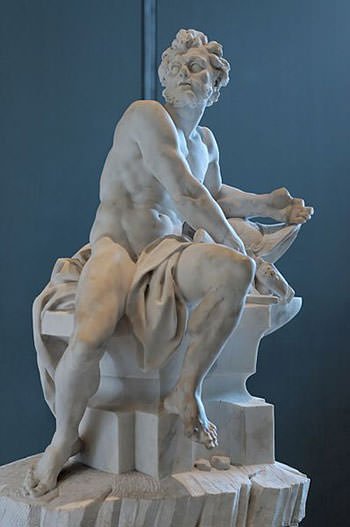
In art, Hephaestus was usually depicted as a burly man, sometimes with a beard. He is generally dressed simply in a tunic and a cap called pilos. He may also be seen carrying the tools of his trade: hammer, tongs, bellows and firebrands. Due to his iconic lameness and ugliness there are also several artistic depictions drawing attention to the same. Though the classical Greek literature only classified Hephaestus as “the lame” or “the halting”, art and imagery over the years have often taken liberty to further physically distort and ridicule the God. The practice continues to the day as may be observed in Disney’s ‘Hercules’, DC’s ‘Justice League Unlimited’ and Sony’s ‘God of War’.
#9 He had several children but none with his wife Aphrodite
In most Greek stories the Goddess of love, sex and beauty Aphrodite is recognized as the consort of Hephaestus. The couple however never produce a child together despite being known to have several progeny outside of their marriage. According to Hesoid, the youngest of the 3 Graces ‘Aglaea’ was married to Hephaestus, by whom she gave birth to Eucleia (“Good Repute”), Eupheme (“Acclaim”), Euthenia (“Prosperity”) and Philophrosyne (“Welcome”). Periphetes, sometimes called Corynetes (club bearer), is said to be the son of Hephaestus with Anticleia. Periphetes was lame in one leg, like his father and had one eye like a Cyclops. Hephaestus is also said to have fathered three sons (Cabeiri) and three Cabeirian nymphs with the sea nymph Cabeiro during his time in Lemnos. These deities were known to have been worshiped in a mystery cult closely associated with that of Hephaestus.

There are other lesser known children attributed to Hephaestus but the most known among his progeny remains Erichthonius, the legendary early ruler of ancient Athens who is considered to be half man and half serpent. It is said that Erichthonius was born from the soil and raised by Athena herself. According to myth, once Hephaestus in mad lust, was trying to force himself on Athena. As the virgin Goddess struggled and pushed him away some of Hephaestus’ semen fell on her thigh. Athena wiped the seed off with a piece of wool and hurled the cloth from Olympus. As the cloth landed on earth, the goddess of earth, Gaea, was accidentally impregnated by the semen of Hephaestus, and thus Erichthonius was born. Athena later raised the child as her own.
#10 The Temple of Hephaestus still stands mostly intact
Located on the north-west side of the ancient Agora in Athens, the ‘Temple of Hephaestus’ still stands mostly intact today on top of the Agoraios Kolonos hill. Built between 449-415 BCE, the structure of the temple is a Doric peripteral, having 6 columns on the short sides (east-west) and 13 columns along the longer sides (north-south). The other major ancient memory of Hephaestus remains on the northern shore of the island of Lemnos in the Aegean Sea, the island where his cult was maintained. In the archaeological remains of Hepheastia, a port town named after the smithing God, is a Greek theater dated to approx 4th century BCE. The 200 capacity Greek theater has now been reconstructed. In 2010, a theater play (Sophocles’ Oedipus Rex) was staged here, perhaps after 2500 years.

